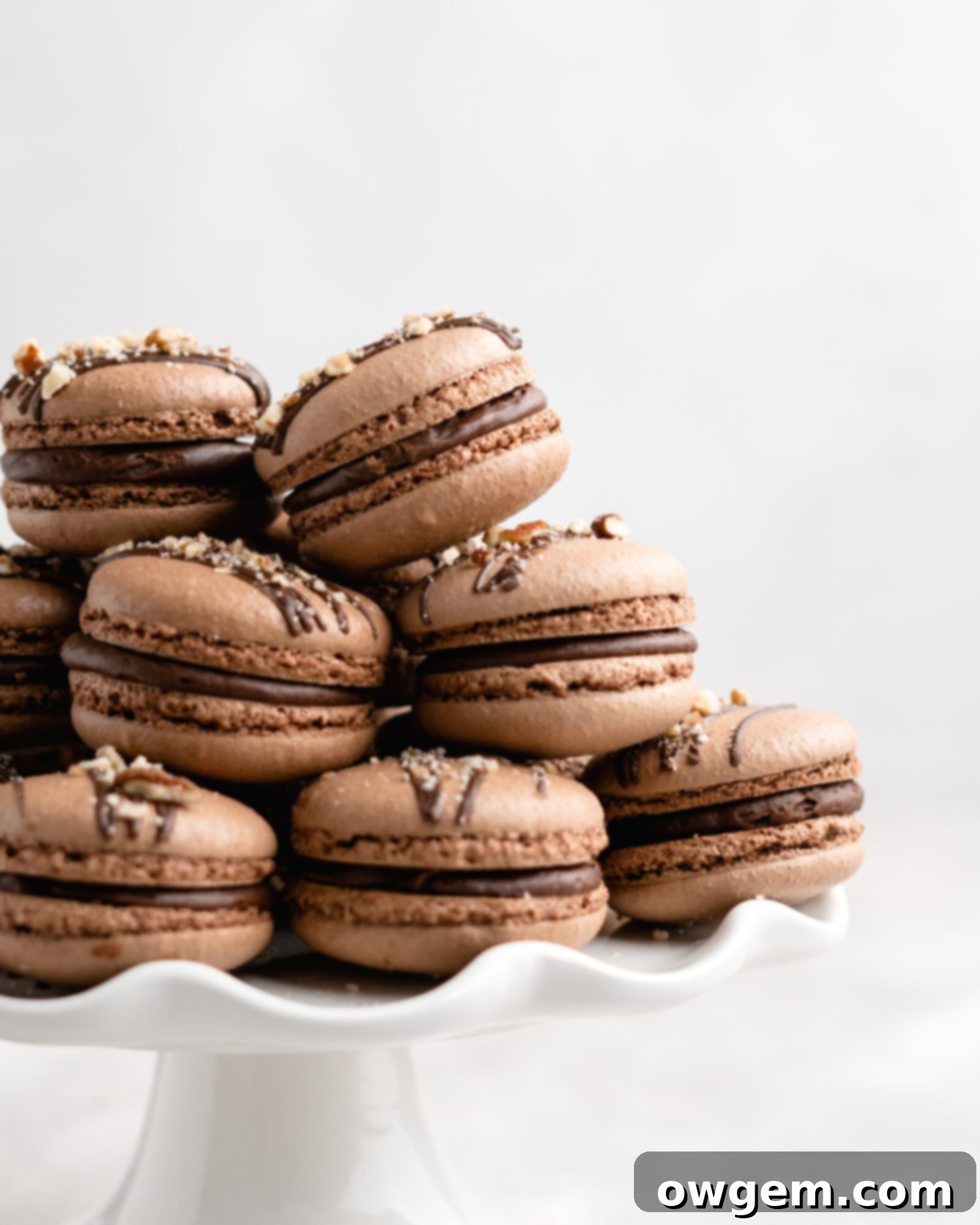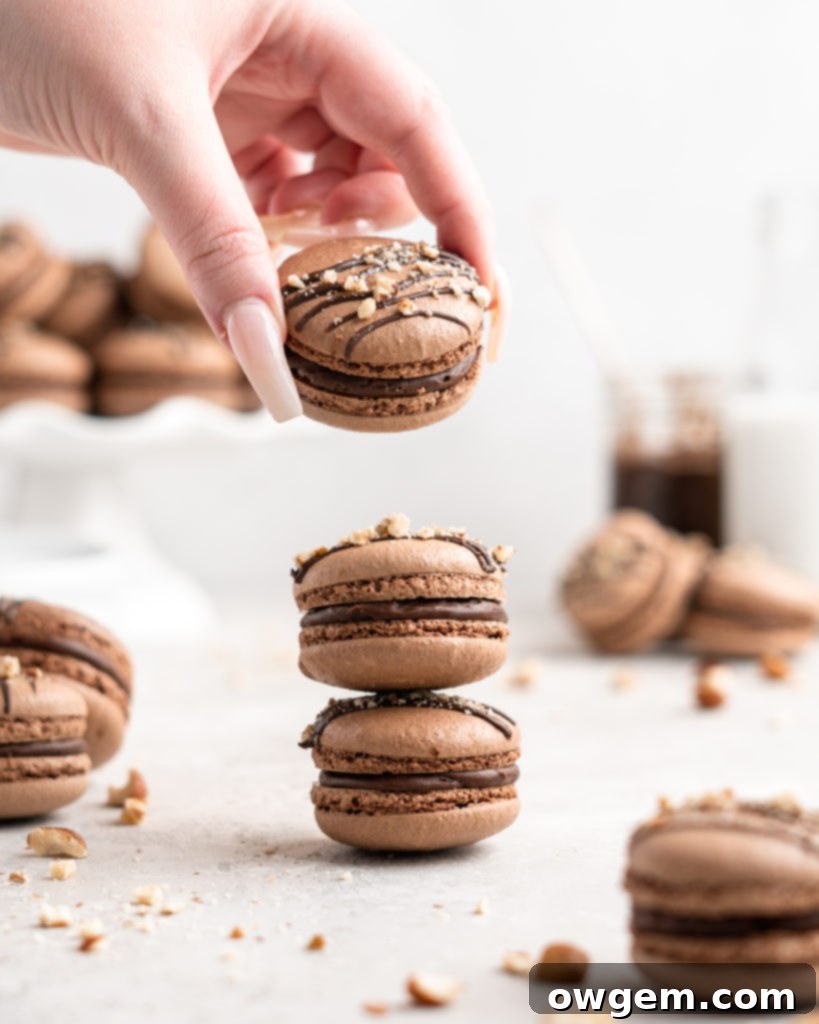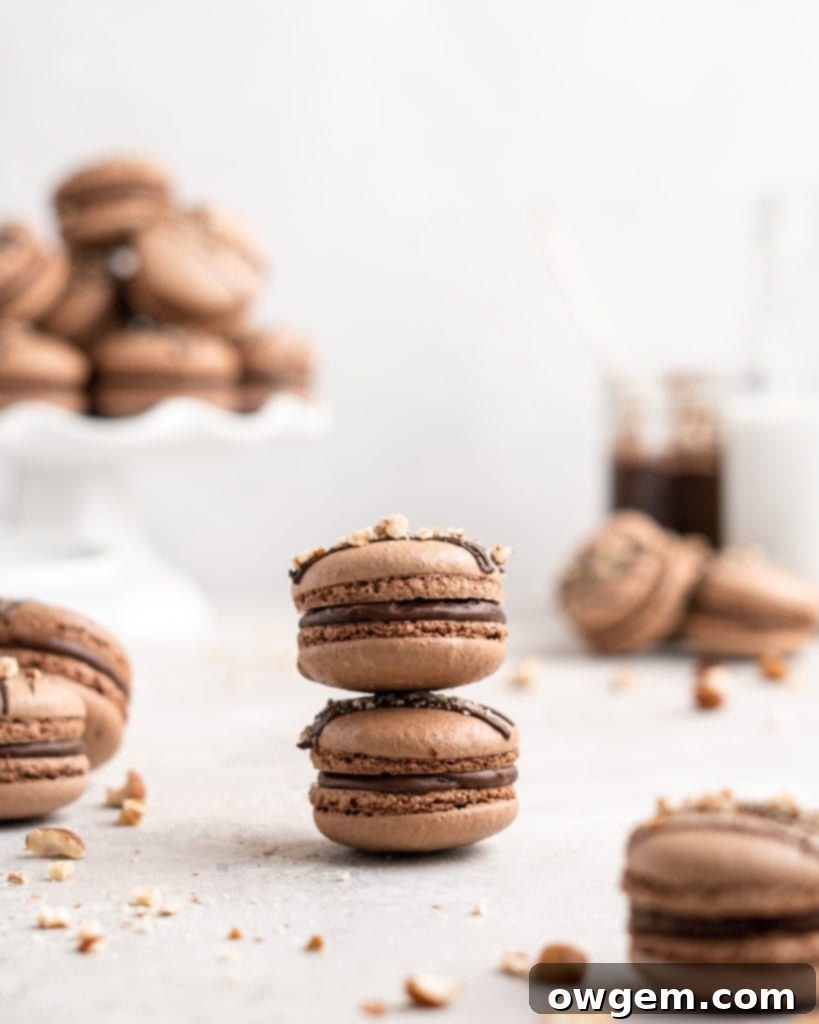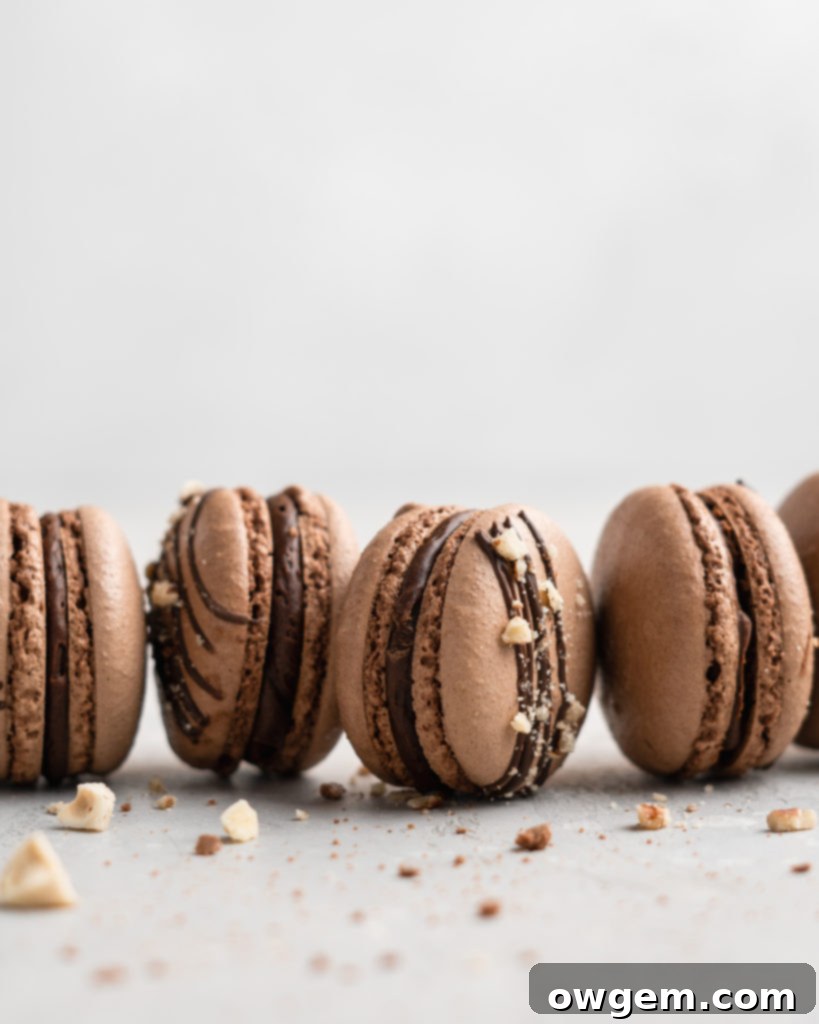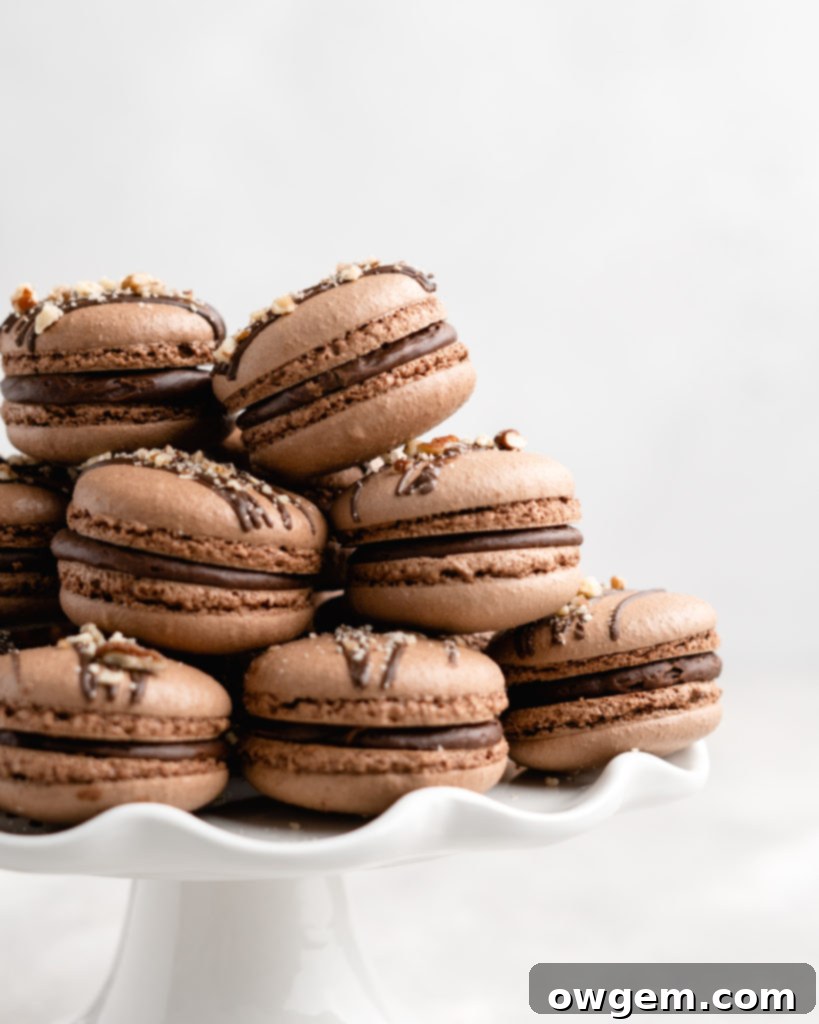Irresistible Nutella Macarons: A Step-by-Step Guide to Decadent Chocolate Delights
Prepare to embark on a truly delightful baking adventure with this exquisite recipe for Nutella Macarons. This isn’t just any macaron; it’s a harmonious blend of classic French confectionery artistry and the universally adored hazelnut-chocolate spread. Each delicate macaron shell, subtly infused with Dutch-processed cocoa powder, offers a rich, deep chocolate flavor that perfectly complements the traditional almond notes. These beautiful, perfectly baked chocolate shells are then generously filled with an effortlessly made Nutella buttercream – a creamy, dreamy concoction that is sweet, nutty, intensely chocolatey, and utterly irresistible. You’ll find yourself battling the urge to simply eat it straight from the beater! For an added touch of elegance and texture, these decadent Nutella Macarons can be adorned with a delicate drizzle of melted chocolate and a sprinkle of finely crushed hazelnuts, elevating them to a truly gourmet dessert.
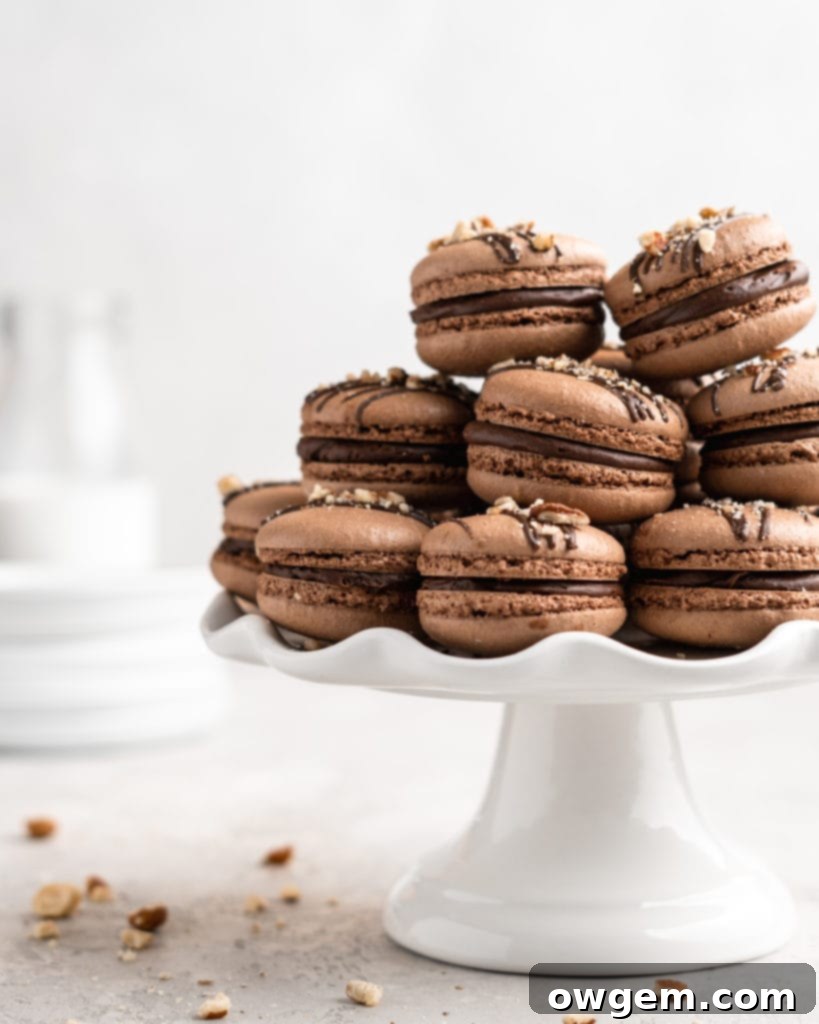
Mastering Macarons: Your Journey to Perfect Shells
The world of macarons can seem intimidating, with its reputation for being finicky and temperamental. However, do not despair if you are new to the art of macaron making! Crafting perfect Nutella macarons, or any macaron for that matter, is an achievable goal with the right guidance and a bit of patience. We understand the challenges, which is why we’ve put together a comprehensive resource to transform you into a confident macaron baker. Our dedicated guide on how to make macarons is brimming with invaluable tips, proven tricks, and a detailed step-by-step process designed to help you achieve those coveted delicate shells with their signature “feet.” From understanding the crucial role of ingredients to mastering the macaronage technique, every aspect is covered. Feel free to explore that guide for in-depth knowledge, and if any questions or concerns arise during your baking journey, please don’t hesitate to leave a comment below!
Essential Tips for Macaron Newbies
Before diving into the Nutella macaron recipe, here are a few foundational tips that every aspiring macaron master should keep in mind:
- **Precision is Key:** Macarons are a science as much as an art. Always weigh your ingredients using a digital kitchen scale for accuracy.
- **Aged Egg Whites:** While not strictly mandatory, aged egg whites (separated a day or two in advance and left at room temperature) tend to whip up better and create a more stable meringue.
- **Sift, Sift, Sift:** Sifting your dry ingredients (almond flour, confectioners’ sugar, and cocoa powder) multiple times is crucial for achieving smooth, bump-free macaron shells.
- **Temperature Matters:** Ensure all ingredients, especially butter for the buttercream, are at room temperature unless otherwise specified. Oven temperature calibration is also vital for even baking.
- **Patience with the “Skin”:** Don’t rush the drying process. The formation of a proper “skin” on your piped shells is essential for developing the characteristic “feet.”
- **Practice Makes Perfect:** Your first batch might not be perfect, and that’s absolutely fine! Each attempt teaches you something new about your oven, your ingredients, and your technique.
The Heart of the Macaron: Understanding Your Ingredients
Every exceptional macaron begins with quality ingredients and a clear understanding of their role. For our Nutella Macarons, the shells themselves are a star, boasting a subtle chocolate flavor that harmonizes beautifully with the filling.
The Shell’s Foundation: Almond Flour & Confectioners Sugar
The delicate texture of a macaron shell comes from finely ground almond flour. It’s crucial that your almond flour is as fine as possible, as any larger granules can lead to bumpy shells. This is why pulsing it with confectioners’ sugar in a food processor, followed by rigorous sifting, is a non-negotiable step. The confectioners’ sugar (also known as powdered sugar or icing sugar) serves multiple purposes: it sweetens the shells, contributes to their structure, and, when combined with almond flour, creates a drier mixture that helps prevent cracking.
The Magic of Meringue: Egg Whites, Sugar, and Water
This recipe utilizes the Italian meringue method, which is often favored by macaron makers for its stability and reliability, especially in humid environments. The meringue is essentially a stable foam created by whipping egg whites and then slowly drizzling in a hot sugar syrup. The heat from the syrup cooks the egg whites, creating a stronger, more stable meringue that is less prone to deflating during the macaronage process. Achieving the correct consistency for both the egg whites (stiff but not dry peaks) and the sugar syrup (precise temperature of 118°C or 244°F) is absolutely critical for a successful batch of macarons.
The Richness Factor: Dutch-Processed Cocoa Powder
The chocolate shells of these Nutella Macarons get their signature flavor and color from Dutch-processed cocoa powder. This ingredient is chosen specifically for its superior qualities compared to regular cocoa powder. Dutch-processed cocoa undergoes an alkalization process that neutralizes its natural acidity. This results in a cocoa powder with a darker, richer color and a less astringent, smoother flavor profile. The reduced acidity allows the pure chocolate notes to shine through more prominently, yielding a taste that is, quite simply, more intensely chocolatey. While regular cocoa powder can be used as a substitute if Dutch-processed is unavailable, we highly recommend investing in the Dutch-processed variety for a truly elevated chocolate macaron experience. You’ll notice a significant difference in both the depth of color and the complexity of flavor. For your convenience, a link to my preferred brand of Dutch-processed cocoa powder can be found here.
Crafting the Exquisite Nutella Buttercream Filling
As previously mentioned, the luscious filling for these Nutella Macarons is a rich, creamy, and undeniably delicious Nutella buttercream. This filling perfectly complements the slightly chocolatey macaron shells, creating a symphony of flavors and textures that will tantalize your taste buds. The recipe for this delectable buttercream is not only simple to follow but also incredibly easy to make, ensuring a smooth and velvety texture every time.
Simple Steps to Silky Perfection
- Beat Butter to Creamy Perfection: Begin by placing your unsalted butter, ensuring it’s at optimal room temperature (soft enough to indent easily but not melted), into a large mixing bowl or the bowl of your stand mixer. Beat the butter on medium-high speed for several minutes until it becomes light, fluffy, and noticeably creamy. This aeration step is crucial for a light buttercream.
- Gradually Incorporate Dry Ingredients: Next, gradually add the confectioners’ sugar and the sifted Dutch-processed cocoa powder to the creamed butter. Start mixing on a low speed to prevent a cloud of sugar and cocoa dust from escaping the bowl. Once the dry ingredients are mostly incorporated, increase the speed and beat again until the sugar and butter are thoroughly combined, smooth, and creamy. Scrape down the sides of the bowl as needed to ensure everything is well-mixed.
- The Nutella & Cream Fusion: Finally, add the rich Nutella and the heavy cream to the mixture. Continue beating on medium-high speed until the buttercream looks perfectly smooth, glossy, creamy, and uniform in color and consistency. The heavy cream helps achieve that silky texture, while the Nutella infuses it with its iconic hazelnut-chocolate flavor. Be sure to mix until no streaks remain, resulting in a perfectly homogeneous and utterly divine filling that you’ll have to resist eating by the spoonful!
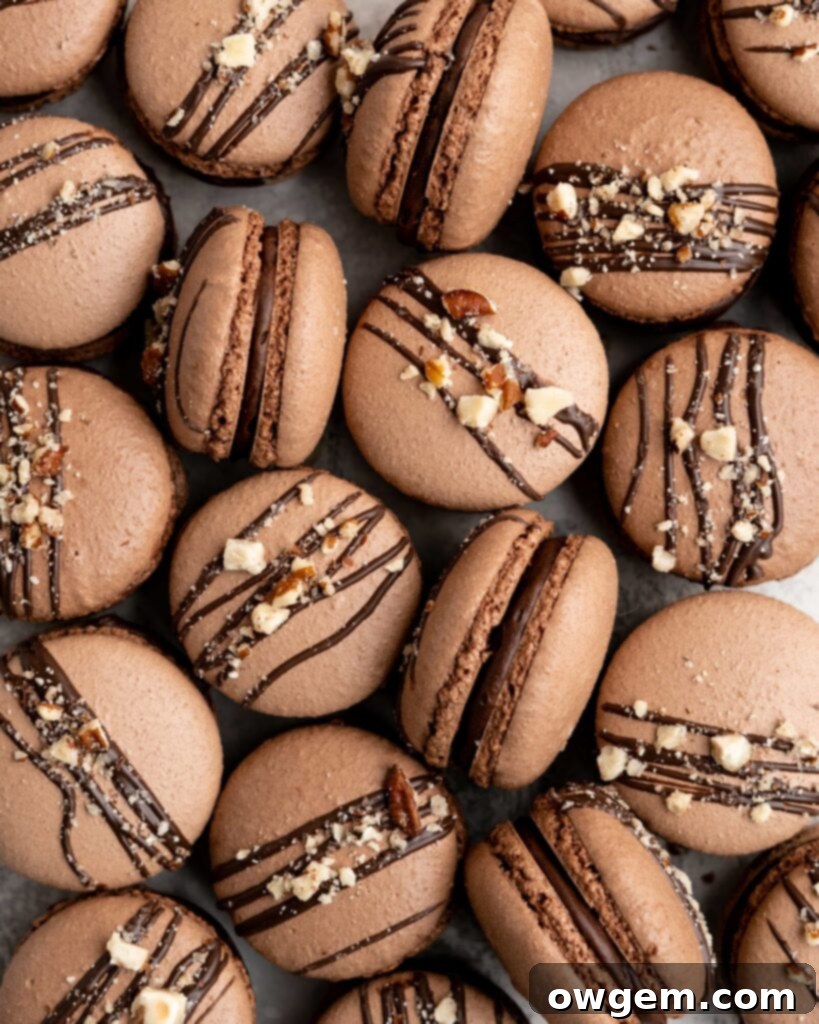
Elevating Your Nutella Macarons: Decoration and Presentation
Once your chocolate macaron shells are baked to perfection and your Nutella buttercream is irresistibly smooth, it’s time for the final, artistic touches that truly make these Nutella Macarons shine. Decoration not only enhances their visual appeal but can also add delightful layers of texture and flavor.
Filling the Shells with Precision
To fill these exquisite macaron shells with the rich Nutella buttercream, I recommend using a piping bag fitted with a medium round tip. This allows for precise and consistent application of the filling. After pairing your cooled macaron halves into “perfect pairs” (matching similar sizes), pipe a generous dollop of buttercream onto the flat side of one shell. Aim for a dollop roughly the same size as the macaron shell itself, or enough to create a beautiful, even filling when the second shell is gently placed on top. The goal is a balanced ratio, ensuring a delightful bite where the crisp shell and creamy filling are perfectly proportioned.
Drizzles, Sprinkles, and Beyond
To further elevate the presentation and flavor of these Nutella Macarons, I like to decorate half of the baked macaron shells – specifically those that will serve as the “tops” – with a simple yet elegant chocolate drizzle and a scattering of crushed hazelnuts. To achieve this, simply melt a small amount of your favorite chocolate (dark or milk works wonderfully) until smooth and fluid. Transfer the hot, melted chocolate into a small piping bag, then snip off a very tiny amount from the bottom corner, creating a minuscule opening. This small hole is key for achieving a delicate, fine drizzle. Next, artfully drizzle the melted chocolate in a zigzag pattern or a random design across the tops of the shells. Immediately, while the chocolate is still wet and before it has a chance to harden, sprinkle a generous amount of finely crushed hazelnuts over the chocolate drizzle. The hazelnuts not only add a beautiful visual contrast but also introduce a fantastic textural crunch and an intensified nutty flavor that beautifully complements the Nutella filling. For an extra touch of indulgence, consider a light dusting of cocoa powder or even miniature chocolate shavings.
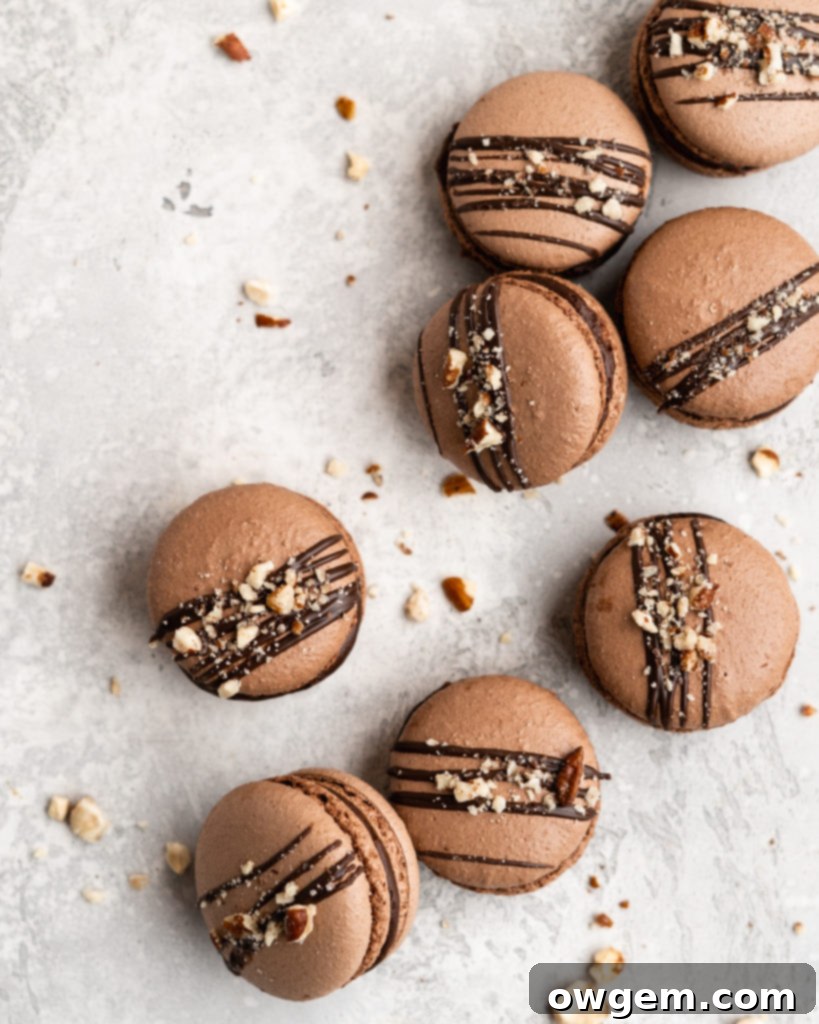
The Journey to Macaron Perfection: Step-by-Step Process
Creating these gorgeous Nutella Macarons is a rewarding process that combines careful technique with delicious results. Below is a detailed breakdown of the steps, ensuring you have all the information needed to successfully bake your own batch of these French-inspired treats. Each stage, from preparing the dry ingredients to the final maturation, plays a crucial role in achieving that perfect macaron experience.
Dry Ingredients Preparation
The foundation of smooth macaron shells begins with the proper preparation of your dry ingredients. The almond flour, confectioners’ sugar, and Dutch-processed cocoa powder must be extremely fine to avoid any lumps or bumps. Pulsing them together in a food processor about 20 times helps to break down any larger pieces in the almond flour and thoroughly combine the ingredients. Following this, sifting the mixture into a large bowl is absolutely essential. Discard any large pieces that remain in the sieve; never be tempted to push them through, as they will compromise the texture of your shells. After sifting, incorporate the first portion of egg whites (75g) into this dry mixture, mixing thoroughly to form a cohesive, somewhat stiff paste. Don’t be afraid to mix aggressively at this stage; we are not yet concerned about deflating air. Once combined, cover the bowl and set it aside to allow the flavors to meld.
Meringue Mastery (Italian Method)
The Italian meringue forms the backbone of stable macaron shells. Begin by adding the remaining 75g of egg whites to the bowl of your stand mixer. Do not start whipping yet. In a small saucepan, combine the white sugar and water, then heat it over medium-high heat. As the sugar syrup heats, keep a close eye on its temperature with a candy thermometer. Once the syrup reaches 110°C (230°F), immediately start beating your egg whites on high speed in the stand mixer. The goal is for both the meringue and the syrup to be ready at precisely the right moment. Continue to heat the syrup until it reaches 118°C (244°F). At this point, the egg whites should have reached stiff peaks but should not appear dry. With the mixer still running on high, slowly and carefully drizzle the hot sugar syrup down the side of the mixing bowl into the whipping egg whites. This slow drizzle is vital to avoid cooking the egg whites too quickly. Continue beating the meringue until it cools down significantly and forms a glossy, thick, and stable mixture that, when the whisk is lifted, creates a firm “bird’s beak” shape. If desired, you can add food coloring at this stage and quickly mix it in, being careful not to overmix.
Macaronage: The Art of Folding
This is perhaps the most crucial stage of macaron making. Begin by adding a large dollop, approximately one-third, of your prepared meringue into the almond paste mixture. At this point, you can be quite vigorous with your mixing, working the meringue into the paste to loosen it up. This step helps to make the paste more pliable and easier to work with, without fear of losing too much air. Once loosened, gently fold in the remaining meringue. The technique for macaronage involves a delicate balance: folding the mixture from the bottom up, scraping down the sides of the bowl, and gently pressing out air. The aim is to achieve the perfect “lava-like” consistency, known as the “ribbon stage.” The batter is ready when, if you lift your spatula, the mixture falls off in a continuous, thick ribbon that slowly melts back into the main batter in about 10-15 seconds. If it falls off in large, V-shaped chunks, it needs further gentle folding. If it’s too runny, you’ve overmixed. This stage requires observation and a delicate touch.
Piping and Developing the Skin
Transfer the perfectly macaronaged batter into a piping bag fitted with a medium to large-sized round tip. On a cookie sheet lined with a silicone baking mat or parchment paper, pipe small, uniform circles of batter. Hold the piping bag straight up, perpendicular to the baking sheet, to ensure even, round shells. Using a macaron stencil or a pre-marked mat can greatly assist in achieving consistent sizes, typically around 1½ inches in diameter. Once all shells are piped, firmly tap the baking sheet multiple times against your counter. This crucial step helps to release any trapped air bubbles within the macaron batter, which can cause cracks during baking. If any stubborn air bubbles remain, gently pop them with a toothpick. Now comes the critical drying stage: allow the piped macarons to sit at room temperature to form a “skin.” This skin is vital; it prevents the macarons from baking outwards and instead forces them upwards, creating those iconic ruffled “feet.” The drying time can vary significantly depending on humidity levels, ranging from 8 minutes to an hour. You’ll know they’re ready when you can lightly touch the surface of a macaron without any batter sticking to your finger. Be sure to check them frequently; over-dried or under-dried shells can both lead to baking issues.
Baking with Care
While your macarons are drying, preheat your oven to 300°F (150°C), or 275°F (135°C) if using a convection mode. Consistent oven temperature is paramount for even baking. Bake the macarons for approximately 15-20 minutes. The exact baking time will depend on the size of your macarons and the specifics of your oven. Begin checking at the 15-minute mark. Macarons are fully baked when their tops are firm and do not wiggle or move from their “feet” when gently nudged. If they still feel soft or movable, continue baking for another minute or two, checking frequently to prevent over-baking. Once baked, allow the macarons to cool completely on the baking sheet or mat before attempting to remove them. Rushing this step can cause them to stick or break. Once cooled, carefully peel them off the surface and sort them into “perfect pairs” of similar sizes, ready for filling.
Assembling the Masterpiece
With the macaron shells and the Nutella buttercream ready, it’s time to bring them together. Fill your piping bag with the prepared Nutella buttercream. Take one half of a macaron pair and pipe a generous dollop of buttercream onto its flat side. A general guideline is to use an amount of icing that is roughly equivalent to a 1:2 ratio of buttercream to macaron (meaning one part buttercream for two macaron halves). Another simple method is to pipe a dollop of filling that is approximately the same size as the initial dollop of macaron batter you piped. Gently place the second macaron half on top, twisting slightly to distribute the filling evenly. Once assembled, these Nutella Macarons require a crucial “maturation” period. Place them in an airtight container and refrigerate for 1-2 days. This allows the moisture from the filling to soften the macaron shells, resulting in that delightful chewiness and allowing the flavors to meld beautifully. Decorate with melted chocolate and crushed hazelnuts just before serving for the ultimate presentation and taste experience.

Get the Recipe:
Nutella Macarons
Pin
Rate
Ingredients
Nutella Macarons
- 200 g Almond Flour
- 200 g Confectioners Sugar
- 20 g Dutch Press Cocoa
- 150 g Egg Whites,, divided
- 190 g White Sugar
- 60 mL Water
Chocolate Nutella Buttercream
- 1/2 cup Unsalted Butter,, at room temperature
- 1 cup Confectioners Sugar
- 1/4 cup Dutch Processed Cocoa Powder,, sifted
- 2/3 cup Nutella
- 1 tbsp Heavy Cream
Equipment
-
Stand mixer
Instructions
Dry Ingredients
-
Place almond flour, confectioners sugar, and cocoa into food processor, pulse about 20 times. Sift into a large bowl, discarding any large pieces. Do not push large pieces through sifter. Then add 75g of egg whites into the bowl. Thoroughly mix together to form a paste. Feel free to be aggressive with your mixing. When combined, cover and set aside.
Making the Meringue
-
Add remaining 75g of egg whites into a stand mixer, and set aside. Meanwhile, add white sugar and water into a small pot, and turn on medium-high. Once mixture heats to 110°C (230°F) turn on stand mixer to high and beat egg whites.
-
When sugar mixture reaches 118°C (244°F) and egg whites have reached stiff peaks (but not dry), slowly drizzle the sugar mixture into the beating egg whites, ensuring that the stream is slow and is drizzling down the side of the bowl first. Then continue to beat the meringue until it reaches the ‘bird beak’ stage. Add food coloring, if desired, at this point and quickly mix into meringue, without overmixing.
Macaronage
-
Add a large dollop of meringue (about 1/3) into the almond mixture paste. Work meringue dollop into paste to loosen up the paste to make it easier to work with. Do not be afraid of being aggressive at this point, we do not need to worry about knocking the air out of this small amount.
-
Add the rest of the meringue into the bowl, and fold it into the paste mixture to combine. Be gentle and careful not to overmix or over-deflate the meringue. The mixture is ready to be piped when it ribbons off your spatula. If it is coming off in large V shaped chunks it still needs to be folded further.
Piping and Drying the Macarons
-
Add mixture into a piping bag with medium to large sized round tip. Pipe small circles of batter onto a cookie sheet fitted with a silicone baking mat or parchment paper. Ensure piping bag is held straight up and perpendicular to baking sheet. Using a stencil or a macaron mat makes this process much easier and fool proof, I try to make my macarons around 1½” in diameter.
-
Tap the baking sheet multiple times against counter to remove any air bubble from the macarons. If some air bubbles still remain, use a tooth pick to gently poke them out.
-
Preheat oven to 300°F, or 275°F for convection mode.
-
While oven is preheating, allow the macarons to sit and form a skin. This skin will ensure the macarons bake up and not out, giving them those classic “feet”. This skin should form anywhere from 8 minutes to an hour. You know the macarons are ready to be baked when you can touch them lightly without having the batter stick to your finger. Keep checking them to see if they have formed a skin– overly dried macarons are just as much of a problem as under-dried macarons!
Baking
-
Bake for 15-20 minutes. Your bake time will depend on the size of your macarons. Check at 15 minutes, and if they are not ready then keep checking every minute. The macarons are ready when the tops are firm and do not move around their base at all.
-
Allow the macarons to cool completely before attempting to remove them from the sheets/mats/parchment. When cooled, find “perfect pairs” of macaron halves and set aside to be filled with buttercream.
Chocolate Nutella Buttecream Filling
-
Add butter to a large mixing bowl and beat until softened. Sift in the confectioners sugar and cocoa powder, then beat until smooth and well-combined.
-
Add Nutella and cream and beat until smooth.
-
Add buttercream into piping bag and pipe onto ½ of “perfect pairs”. The amount of icing should be a 1:2 ratio, 1-part buttercream and 2-parts (2 halves) macarons. The other way to get a perfect icing amount is to pipe the same dollop of icing as you did with the macaron batter. Add tops to bottoms, and place into refrigerator to “mature” for 1-2 days.
-
Decorate with melted chocolate and crushed hazelnuts.
